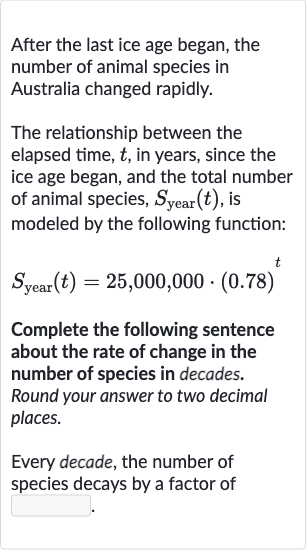AI tutor
Welcome to Bytelearn!
Let’s check out your problem:

After the last ice age began, the number of animal species in Australia changed rapidly.The relationship between the elapsed time, , in years, since the ice age began, and the total number of animal species, , is modeled by the following function:Complete the following sentence about the rate of change in the number of species in decades. Round your answer to two decimal places.Every decade, the number of species decays by a factor of
Full solution
Q. After the last ice age began, the number of animal species in Australia changed rapidly.The relationship between the elapsed time, , in years, since the ice age began, and the total number of animal species, , is modeled by the following function:Complete the following sentence about the rate of change in the number of species in decades. Round your answer to two decimal places.Every decade, the number of species decays by a factor of
- Identify Function and Value: Identify the given function and the value to find.The function given is , where is the time in years since the ice age began. We need to find the decay factor for every decade ( years).
- Calculate Decay Factor: Calculate the decay factor for one decade.To find the decay factor for one decade, we need to substitute into the function because one decade is equivalent to years.
- Perform Calculation for : Perform the calculation for . First, calculate .
- Multiply to Find Species: Multiply the result by to find the number of species after one decade.
- Determine Decay Factor: Determine the decay factor by comparing the number of species at and . Initially, at , the number of species is . After one decade, the number of species is approximately . To find the decay factor, we divide the number of species after one decade by the initial number of species. Decay factor
- Perform Division: Perform the division to find the decay factor.Decay factor Decay factor
- Round Decay Factor: Round the decay factor to two decimal places.Decay factor (rounded to two decimal places)
More problems from Compound interest: word problems
QuestionGet tutor help
QuestionGet tutor help
QuestionGet tutor help
QuestionGet tutor help
QuestionGet tutor help
QuestionGet tutor help
QuestionGet tutor help
QuestionGet tutor help
QuestionGet tutor help
